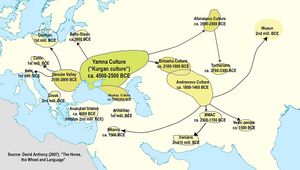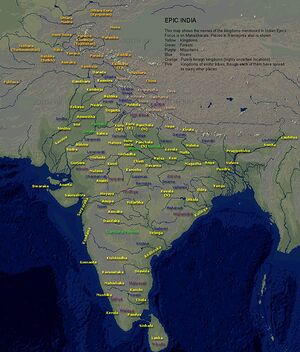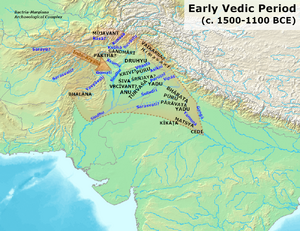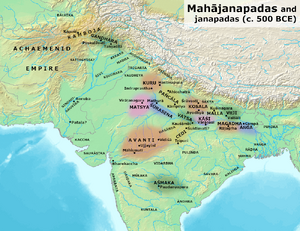Indo-Aryan peoples
| Author:Laxman Burdak, IFS (R) |
This is a partial List of Indo-Aryan peoples that are mentioned in the literature of Indic religions.
From the second or first millennium BCE, ancient Indo-Aryan peoples and tribes turned into most of the population in the northern part of the Indian subcontinent – Indus Valley (roughly today's Punjab), Western India, Northern India, Central India, and also in areas of the southern part like Sri Lanka and the Maldives through and after a complex process of migration, assimilation of other peoples and language shift.[1][2][3]
Vedic people
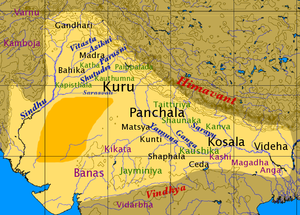
- Alinas (RV 7.18.7)
- Anu (RV 1.108.8, RV 8.10.5)
- Āyu
- Bhajeratha
- Bhalanas
- Bharatas- The Bharatas are a major Aryan clan mentioned in the Rigveda, especially in Mandala 3 attributed to the Bharata sage Vishvamitra. The entire Bharata clan is described as crossing over, with their chariots and wagons, at the confluence of the Vipash (Beas River) and Shutudri (Satlej). The Bharatas are mentioned as the protagonists in the Battle of the Ten Kings in Mandala 7 (7.18 etc.), where they are on the winning side. They appear to have been successful in the early power-struggles between the various Aryan and non-Aryan clans so that they continue to dominate in post-Rigvedic texts, and later in the (Epic) tradition. "Bhārata" today is the official name of the Republic of India (see also Etymology of India).
- Chedi
- Dasa
- Dasyu
- Dṛbhīka
- Druhyus (Rigveda, RV 1.108.8, RV 8.10.5)
- Gandhara
- Guṅgu
- Ikshvaku
- Krivi
- Kīkaṭa
- Kuru
- Mahīna
- Malankhara
- Maujavant
- Matsya
- Nahuṣa
- Paktha
- Panis
- Pārāvata
- Parsu (Parśu)
- Puru (Pūru)
- Ruśama (RV Mandala 8)
- Sārasvata
- Srñjaya
- Tritsu (RV 7.18, 7.33, 7.83)
- Yadu: Of Indo-Aryan origin, Yadu is one of the five early Rigvedic tribes (panchajana, panchakrishtya or panchamanusha) mentioned in the Rigveda.[4][5][6] The Yadus had a tribal union with the Turvasha tribe, and were frequently described together.[7][8] The Yadus were a Aryan tribe.[9] By the time of the arrival of the Puru and Bharata tribes, the Yadu-Turvashas were settled in Punjab, with the Yadus possibly residing along the Yamuna River.[10] In Mandalas 4 and 5 of the Rigveda, the god Indra is stated to have saved the Yadu-Turvashas from drowning when they crossed rivers.[11][12] In Mandala 6, the Yadu-Turvashas are stated to have been "brought from far away" by Indra.[13][14] The Yadu-Turvashas are treated relatively positively in Mandalas 5, 6, and 8,[15] and are stated to be the occasional allies and enemies of the Puru-Bharatas.[16] In the Battle of the Ten Kings, the Yadus were defeated by Bharata chieftain Sudas.[17]
Pancha Jana
Pancha Jana (पञ्च जना – Páñca Jánāḥ / Pancha-janah) The pancha Jana are five tribes inexplicitly listed together during the (Āryāvarta of this time, c. 1700–1500 BCE, roughly corresponds with the Punjab and closer regions) (see the map of Early Vedic Period)
- Anu (in the southwest part of early Āryāvarta)
- Druhyu (in the north part of early Āryāvarta)
- Puru (ancestors of the Paurava) (in the centre and east parts of early Āryāvarta, including Sarasvati river region)
- Turvaśa (Turvasha) (in the centre and south parts of early Āryāvarta): The Turvashas (Sanskrit: तुर्वश, Turvaśa) were one of the five major peoples[18] (panchajana, panchakrishtya or panchamanusha) mentioned in the Rigveda. [19] The Turvashas had a tribal union with the Yadu tribe, and were frequently described together.[20][21] The Turvashas were a partly Indo-Aryan-acculturated Indus tribe.[22] By the time of the arrival of the Puru and Bharata tribes, the Yadu-Turvashas were settled in Punjab.[23] By the time of the Shatapatha Brahmana (7th-6th centuries BCE),[24][25] the Turvashas are linked to the Panchalas.[26]
- Alfred Ludvig first conjectured that Turvīti and Vayya could have been connected with the Turvasha tribe, a notion that is still considered only speculation according to Witzel.[27][26] In Mandalas 4 and 5 of the Rigveda, the god Indra is stated to have saved the Yadu-Turvashas from drowning when they crossed rivers.[28][29] In Mandala 6, the Yadu-Turvashas are stated to have been "brought from far away" by Indra.[30][31] The Yadu-Turvashas are treated relatively positively in Mandalas 5, 6, and 8,[32] and are stated to be the occasional allies and enemies of the Puru-Bharatas.[33]
- Yadu (in the southeast and south parts of early Āryāvarta)
Janapadas
Early Janapadas peoples (c. 1700–1100 BCE)
After roughly 1700 BCE Indo-Aryan peoples and tribes were swiftly expanding through ancient northern India, therefore the number of peoples, tribes and clans was increasing (as well as the number of Indo-Aryan language speakers) and Āryāvarta was becoming a very large area (see the map on the right side).
- Aja – (Madhya-desha Āryāvarta – Central Āryāvarta)
- Ambaśṭha – (Madhya-desha Āryāvarta – Central Āryāvarta)
- Aṅga – Prachya Āryāvarta – Eastern Āryāvarta (Madhya-desha and Prachya Āryāvarta – Central and Eastern Āryāvarta in Vamana).
- Anu – is a Vedic Sanskrit term for one of the 5 major tribes in the Rigveda, RV 1.108.8, RV 8.10.5 (both times listed together with the Druhyu) and, much later also in the Mahabharata.[34] In the late Vedic period, one of the Anu kings, King Anga, is mentioned as a "chakravartin" (AB 8.22). Ānava, the vrddhi derivation of Anu, is the name of a ruler in the Rigvedic account of the Battle of the Ten Kings (7.18.13) and at 8.4.1 with the Turvaśa (tribe). The meaning ánu "living, human" (Naighantu) cannot be substantiated for the Rigveda [35] and may have been derived from the tribal name. (Pratichya Āryāvarta – Western Āryāvarta)
- Āyu [36]–
- Bhajeratha [37]
- Bhalana – The Bhalanas were one of the tribes that fought against Sudas in the Dasarajna battle. Some scholars have argued that the Bhalanas lived in South Central and Western Pakistan, and that the Bolan Pass, around which live the Brahui people, are the Bhalana people and abode.[38] (Pratichya Āryāvarta – Western Āryāvarta)
- Bharadvāja – (Madhya-desha Āryāvarta – Central Āryāvarta)
- Bhrigus [39]
- Bheda – (Madhya-desha Āryāvarta – Central Āryāvarta)
- Bodha – (Madhya-desha Āryāvarta – Central Āryāvarta)
- Druhyu – The Druhyu were a people of Vedic India. They are mentioned in the Rigveda,[40] usually together with the Anu tribe.[41] Some early scholars have placed them in the northwestern region.[42] The later texts, the Epic and the Puranas, locate them in the "north", that is, in Gandhara, Aratta and Setu. (Vishnu Purana IV.17) The Druhyus were driven out of the land of the seven rivers, and their next king, Gandhara, settled in a north-western region which became known as Gandhāra. The sons of the later Druhyu king Pracetas too settle in the "northern" (udīcya) region (Bhagavata 9.23.15–16; Visnu 4.17.5; Vayu 99.11–12; Brahmanda 3.74.11–12 and Matsya 48.9.). Recently, some writers[43] have confirmed that the Druhyu are the ancestors of the European peoples, or of the Celtic Druid class.[44] The word Druid (Gallic Celtic druides), however, is derived from Proto-Indo-European vid "to see, to know' [45] It has also been alleged that the Rg Veda and the Puranas describe this tribe as migrating North,.[46][47] However, there is nothing of this in the Rigveda and the Puranas merely mention that the Druhyu are "adjacent (āśrita) to the North". (Pratichya Āryāvarta – Western Āryāvarta)
- Gandharis [48] (Pratichya Āryāvarta – Western Āryāvarta)
- Kārūṣa (Karusha) – later Cedi (Chedi) (Madhya-desha Āryāvarta – Central Āryāvarta)
- Keśin (Madhya-desha Āryāvarta – Central Āryāvarta)
- Kīkaṭa[51] (Prachya Āryāvarta – Eastern Āryāvarta)
- Kosala (Prachya Āryāvarta – Eastern Āryāvarta)
- Krivi[52] (Madhya-desha Āryāvarta – Central Āryāvarta)
- Kunti (Madhya-desha Āryāvarta – Central Āryāvarta)
- Madra (Udichya Āryāvarta – Northern Āryāvarta)
- Uttara Madra (Udichya Āryāvarta – Northern Āryāvarta)
- Magadha (Prachya Āryāvarta – Eastern Āryāvarta)
- Mahāvṛṣa (Mahavrisha) (Udichya Āryāvarta – Northern Āryāvarta)
- Mahīna[53]
- Malankhara[54]
- Matsya[55](Madhya-desha Āryāvarta – Central Āryāvarta)
- Mūjavana / Maujavant[46] (Udichya Āryāvarta – Northern Āryāvarta)
- Nahuṣa[56]
- Pāñcala (Panchala) (Madhya-desha Āryāvarta – Central Āryāvarta)
- Pārāvata (Madhya-desha Āryāvarta – Central Āryāvarta)
- Pṛthu (Prithu) (Pratichya Āryāvarta – Western Āryāvarta)
- Pūru (Puru) (Madhya-desha Āryāvarta – Central Āryāvarta)
- Bharatas – The Bharatas are an Aryan tribe mentioned in the Rigveda, especially in Mandala 3 attributed to the Bharata sage Vishvamitra and in and Mandala 7.[57] Bharatá is also used as a name of Agni (literally, "to be maintained", viz. the fire having to be kept alive by the care of men), and as a name of Rudra in RV 2.36.8. In one of the "river hymns" RV 3.33, the entire Bharata tribe is described as crossing over, with their chariots and wagons, at the confluence of the Vipash (Beas) and Shutudri (Satlej). Hymns by Vasistha in Mandala 7 (7.18 etc.) mention the Bharatas as the protagonists in the Battle of the Ten Kings, where they are on the winning side. They appear to have been successful in the early power-struggles between the various Aryan and non-Aryan tribes so that they continue to dominate in post-Rigvedic texts, and later in the (Epic) tradition, the Mahābhārata, the eponymous ancestor becomes Emperor Bharata, conqueror of 'all of India', and his tribe and kingdom is called Bhārata. "Bhārata" today is the official name of the Republic of India (see also Etymology of India). (Madhya-desha Āryāvarta – Central Āryāvarta)
- Kuru[58] – Ancestors of the Kaurava (Madhya-desha Āryāvarta – Central Āryāvarta)
- Uttara Kuru (Udichya Āryāvarta – Northern Āryāvarta)
- Pandu – Ancestors of the Pandava (Udichya Āryāvarta – Northern Āryāvarta)
- Kuru[58] – Ancestors of the Kaurava (Madhya-desha Āryāvarta – Central Āryāvarta)
- Bharatas – The Bharatas are an Aryan tribe mentioned in the Rigveda, especially in Mandala 3 attributed to the Bharata sage Vishvamitra and in and Mandala 7.[57] Bharatá is also used as a name of Agni (literally, "to be maintained", viz. the fire having to be kept alive by the care of men), and as a name of Rudra in RV 2.36.8. In one of the "river hymns" RV 3.33, the entire Bharata tribe is described as crossing over, with their chariots and wagons, at the confluence of the Vipash (Beas) and Shutudri (Satlej). Hymns by Vasistha in Mandala 7 (7.18 etc.) mention the Bharatas as the protagonists in the Battle of the Ten Kings, where they are on the winning side. They appear to have been successful in the early power-struggles between the various Aryan and non-Aryan tribes so that they continue to dominate in post-Rigvedic texts, and later in the (Epic) tradition, the Mahābhārata, the eponymous ancestor becomes Emperor Bharata, conqueror of 'all of India', and his tribe and kingdom is called Bhārata. "Bhārata" today is the official name of the Republic of India (see also Etymology of India). (Madhya-desha Āryāvarta – Central Āryāvarta)
- Tṛtsu (Tritsu) The Tritsus are a sub-group of the Puru who are distinct from the Bharatas mentioned in Mandala 7 of the Rigveda (in hymns 18, 33 and 83). Under king Sudas they defeated the confederation of ten kings led by the Bharatas at the Battle of the Ten Kings. (Madhya-desha Āryāvarta – Central Āryāvarta)
- Ruśama (Madhya-desha Āryāvarta – Central Āryāvarta)
- Śālva (Shalva) (Madhya-desha Āryāvarta – Central Āryāvarta)
- Sārasvata – people that dwelt the banks of the Sarasvati river (Pratichya Āryāvarta – Western Āryāvarta)
- Satvanta (Dakshina Āryāvarta – Southern Āryāvarta)
- Śigru (Madhya-desha Āryāvarta – Central Āryāvarta)
- Śiva (Shiva, not to be confused with the God Śiva or Shiva) (Pratichya Āryāvarta – Western Āryāvarta)
- Srñjaya (Srinjaya) (Madhya-desha Āryāvarta – Central Āryāvarta)
- Śvikna (Madhya-desha Āryāvarta – Central Āryāvarta)
- Turvaśa (Turvasa)
- Uśīnara (Ushinara) (Madhya-desha Āryāvarta – Central Āryāvarta)
- Vaikarṇa (Vaikarna) (Udichya Āryāvarta – Northern Āryāvarta)
- Vaṅga (Vanga) (Prachya Āryāvarta – Eastern Āryāvarta)
- Varaśikha (Varashikha) (Madhya-desha Āryāvarta – Central Āryāvarta)
- Vaśa (Vasha) (Madhya-desha Āryāvarta – Central Āryāvarta)
- Vidarbha (Vidarbha, Dakshina Āryāvarta – Southern Āryāvarta)
- Videha (Mithila, Prachya Āryāvarta – Eastern Āryāvarta)
- Viśaṇin (Vishanin) (Pratichya Āryāvarta – Western Āryāvarta)
- Vṛcivanta (Vrichivanta) (Pratichya Āryāvarta – Western Āryāvarta)
- Yadu (Dakshina Āryāvarta – Southern Āryāvarta)
- Yakṣu (Yakshu) (Madhya-desha Āryāvarta – Central Āryāvarta)
Late Janapadas peoples (c. 1100–500 BCE)
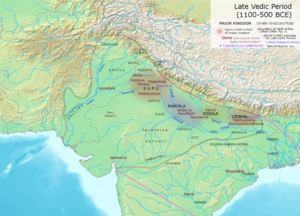
From roughly 1100 to 500 BCE Indo-Aryan peoples and tribes expanded even further throughout ancient northern India (see the map).
- Abhīṣaha (Abhishaha) / Apanga (Vayu) / Aupadha (Markandeya) / Alasa (Vamana) – (Udichya Āryāvarta – Northern Āryāvarta)
- Āhuka / Kuhaka (Markandeya) / Kuhuka (Vamana) – (Udichya Āryāvarta – Northern Āryāvarta)
- Alimadra / Anibhadra (Markandeya) / Alibhadra (Vamana) – (Udichya Āryāvarta – Northern Āryāvarta)
- Aṅga – (Madhya-desha and Prachya Āryāvarta – Central and Eastern Āryāvarta in Vamana)
- Āntaranarmada / Uttaranarmada (Markandeya), Sunarmada (Vamana) – (Aparanta Āryāvarta – Western Āryāvarta)
- Antargiri – (Prachya Āryāvarta – Eastern Āryāvarta)
- Anūpa / Arūpa (Matsya), Annaja (Vayu) – (Vindhya-prashtha Āryāvarta – Vindhyan Āryāvarta)
- Aparānta / Purandhra (Matsya), Aparīta (Vayu) – (Udichya Āryāvarta – Northern Āryāvarta)
- Arthapa / Atharva (Markandeya) – (Madhya-desha Āryāvarta – Central Āryāvarta)
- Aśvakūṭa – (Madhya-desha Āryāvarta – Central Āryāvarta)
- Ātreya / Atri (Matsya, Brahmanda) – (Udichya Āryāvarta – Northern Āryāvarta)
- Audumbara / Audambara / Audumvara – (Udichya Āryāvarta – Northern Āryāvarta)
- Auṇḍra – (Vindhya-prashtha Āryāvarta – Vindhyan Āryāvarta)
- Bahirgiri – (Prachya Āryāvarta – Eastern Āryāvarta)
- Bhadra – (Prachya and Madhya-desha Āryāvarta – Eastern and Central Āryāvarta)
- Bhadrakāra – (Madhya-desha Āryāvarta – Central Āryāvarta)
- Bharadvāja – (Udichya Āryāvarta – Northern Āryāvarta)
- Bhārgava – (Prachya Āryāvarta – Eastern Āryāvarta)
- Bharukaccha / Bhanukaccha (Vayu), Bhīrukahcha (Markandeya), Dārukachchha (Vamana), Sahakaccha (Brahmanda) – (Aparanta Āryāvarta – Western Āryāvarta)
- Bhogavardhana / Bhokardan (Dakshinapatha Āryāvarta – Southern Āryāvarta)
- Bhūṣika (Bhushika) – (Udichya Āryāvarta – Northern Āryāvarta)
- Bodha / Bāhya (Matsya) – (Madhya-desha Āryāvarta – Central Āryāvarta)
- Brahmottara / Suhmottara (Matsya), Samantara (Brahmanda) – (Prachya Āryāvarta – Eastern Āryāvarta)
- Carmakhaṇḍika (Charmakhandika) / Attakhaṇḍika (Matsya), Sakheṭaka (Vamana) – (Udichya Āryāvarta – Northern Āryāvarta)
- Darada – (Udichya Āryāvarta – Northern Āryāvarta)
- Darva – (Himalayan and Northern in Vayu and Markandeya, Parvata-shrayin and Udichya Āryāvarta – Himalayan Āryāvarta)
- Daśeraka (Dasheraka) / Karseruka (Vayu), Kuśeruka (Markandeya) – (Udichya Āryāvarta – Northern Āryāvarta)
- Daśamālika (Dashamalika) / Daśanāmaka (Matsya), Daśamānika (Vayu), Daṅśana (Vamana) – (Udichya Āryāvarta – Northern Āryāvarta)
- Daśarṇa (Dasharna) (Vindhya-prashtha Āryāvarta – Vindhyan Āryāvarta)
- Druhyu / Hrada (Vayu), Bhadra (Brahmanda) – (Udichya Āryāvarta – Northern Āryāvarta)
- Durga / Durgala (Brahmanda) – (Aparanta Āryāvarta – Western Āryāvarta)
- Ganaka – (Udichya Āryāvarta – Northern Āryāvarta)
- Gāndhāra / Gandharians (Vaēkərəta in Avestan) – the people who lived in Gāndhāra and spoke Gandhari (Udichya Āryāvarta – Northern Āryāvarta)
- Gonarda / Govinda (Vayu), Gomanta (Markandeya), Mananda (Vamana) – (Prachya Āryāvarta – Eastern Āryāvarta)
- Haṃsamārga / Sarvaga (Himalayan) in Matsya; Haṃsamārga (Northern and Himalayan) in Vayu and Markandeya; Karnamārga (Northern) and Haṃsamārga (Himalayan) in Vamana; Haṃsamārga (Himalayan) Haṃsabhaṅga (Northern) in Brahmanda – (Udichya Āryāvarta – Northern Āryāvarta; Parvata-shrayin Āryāvarta – Himalayan Āryāvarta)
- Hāramuṣika (Haramushika) / Hāramūrtika (Matsya), Hārapūrika (Vayu), Sāmuṣaka (Vamana) – (Udichya Āryāvarta – Northern Āryāvarta)
- Huhuka / Samudgaka (Matsya), Sahūdaka (Vayu), Sakṛtraka (Markandeya), Śahuhūka (Vamana), Sahuhūka (Brahmanda) – (Parvata-shrayin Āryāvarta – Himalayan Āryāvarta)
- Ijika (Udichya Āryāvarta – Northern Āryāvarta)
- Jaguda / Jāṇgala (Matsya), Juhuḍa (Vayu), Jāguḍa (Markandeya) – (Udichya Āryāvarta – Northern Āryāvarta)
- Jāṇgala – (Madhya-desha Āryāvarta – Central Āryāvarta)
- Jñeyamarthaka Jñeyamallaka (Markandeya), Aṅgiyamarṣaka (Vamana), Gopapārthiva (Brahmanda) – (Aparanta Āryāvarta – Western Āryāvarta)
- Kachchhika / Kāchchhīka (Matsya), Kacchīya (Vayu), Kāśmīra (Markandeya), Kacchipa (Brahmanda) – (Aparanta Āryāvarta – Western Āryāvarta)
- Kālatoyaka – (Udichya Āryāvarta – Northern Āryāvarta)
- Kaliṅga (central) / Arkalinga (Markandeya) – (Madhya-desha Āryāvarta – Central Āryāvarta)
- Kaliṅga (southern) – (Dakshinapatha Āryāvarta – Southern Āryāvarta)
- Kalitaka / Kālītaka (Vayu), Anīkaṭa (Markandeya), Tālīkaṭa (Vamana), Kuntala (Brahmanda) – (Aparanta Āryāvarta – Western Āryāvarta)
- Kalivana / Kolavana (Vayu), Kālivala (Markandeya), Vāridhana (Vamana), Kalivana (Brahmanda) – (Aparanta Āryāvarta – Western Āryāvarta)
- Kantakara / Kanṭakāra (Matsya), Raddhakaṭaka (Vayu), Bahubhadra (Markandeya), Kādhara (Vamana) – (Udichya Āryāvarta – Northern Āryāvarta)
- Kāraskara / Paraṣkara (Vayu), Kaṭhākṣara (Markandeya), Karandhara (Brahmanda) – (Aparanta Āryāvarta – Western Āryāvarta)
- Kārūṣa (Karusha), later Cedi (Chedi) – Southern and Vindhyan Āryāvarta (Matsya) (Dakshinapatha Āryāvarta – Southern Āryāvarta; Vindhya-prashtha Āryāvarta – Vindhyan Āryāvarta)
- Kāśi (Kashi) (Madhya-desha Āryāvarta – Central Āryāvarta)
- Kasmira (Kashmira / Kāmīra) – (Udichya Āryāvarta – Northern Āryāvarta)
- Kathas – in the River Chenab Valley (Udichya Āryāvarta – Northern Āryāvarta)
- Kauśika – (Madhya-desha Āryāvarta – Central Āryāvarta)
- Kekeya / Kaikeyya (Matsya), Kaikeya (Markandeya), Kaikeya (Vamana) – (Udichya Āryāvarta – Northern Āryāvarta)
- Khaśa / Khasha – Khaśa (Vamana), Śaka (Brahmanda) – (Parvata-shrayin Āryāvarta – Himalayan Āryāvarta)
- Kisaṇṇa – (Madhya-desha Āryāvarta – Central Āryāvarta)
- Koṅkaṇa – (Dakshinapatha Āryāvarta – Southern Āryāvarta)
- Kośala (Central) – (Madhya-desha Āryāvarta – Central Āryāvarta)
- Kośala (Vindhyan) – (Vindhya-prashtha Āryāvarta – Vindhyan Āryāvarta)
- Kukkuṭa – (Udichya Āryāvarta – Northern Āryāvarta)
- Kulūta / Ulūta (Brahmanda) – (Udichya Āryāvarta – Northern Āryāvarta)
- Kulya – only Central in Markandeya; only Southern in Vamana and Brahmanda – (Dakshinapatha Āryāvarta – Southern Āryāvarta; Madhya-desha – Central Āryāvarta)
- Kuninda / Pulinda (Matsya), Kaliṅga (Markandeya), Kalinda (Brahmanda) – (Udichya Āryāvarta – Northern Āryāvarta)
- Kuśalya (Kushalya) – (Madhya-desha Āryāvarta – Central Āryāvarta)
- Kuśūdra (Kushudra) – (Madhya-desha Āryāvarta – Central Āryāvarta)
- Kuthaprāvaraṇa / Kuśaprāvaraṇa (Vayu), Kuntaprāvaraṇa (Markandeya), Apaprāvaraṇa (Brahmanda) – (Parvata-shrayin Āryāvarta – Himalayan Āryāvarta)
- Lalhitta – (Udichya Āryāvarta – Northern Āryāvarta)
- Lampāka / Lamaka (Brahmanda) – (Udichya Āryāvarta – Northern Āryāvarta)
- Madguraka / Mudgara (Markandeya), Mudagaraka (Brahmanda) – (Prachya Āryāvarta – Eastern Āryāvarta)
- Madras – in the River Chenab Valley (Udichya Āryāvarta – Northern Āryāvarta)
- Mādreya – (Madhya-desha Āryāvarta – Central Āryāvarta)
- Magadha / Central and Eastern in Vayu and Brahmanda – Magadha (Prachya Āryāvarta – Eastern *Āryāvarta)
- Maharāṣṭra (Maharashtra) / Navarāṣṭra (Matsya) – Maharashtra (Dakshinapatha Āryāvarta – Southern Āryāvarta)
- Māheya – (Aparanta Āryāvarta – Western Āryāvarta)
- Mālada / Mālava (Matsya), Manada (Markandeya), Mansāda (Vamana) – (Prachya Āryāvarta – Eastern Āryāvarta)
- Malaka – (Madhya-desha Āryāvarta – Central Āryāvarta)
- Malavartika – Mallavarṇaka (Matsya), Mālavartin (Vayu), Mānavartika (Markandeya), Baladantika (Vamana) – (Prachya Āryāvarta – Eastern Āryāvarta)
- Mālava / Western Malla (known as Malloí by the ancient Greeks and Malli by ancient Romans) – they were a people from southern Punjab, including today's Multan city (Mallorum Metropolis) and region, south of the confluence of the Jhelum, Hydaspes for the Greeks, and Ravi, Hydraotes for the Greeks, rivers (see map of Mahajanapadas), they are mentioned by ancient Greek historians[59][60] in the telling of Alexander III of Macedon's or Alexander the Great (Iskandar) Mallian Campaign; Malada (Brahmanda), Ekalavya (Vamana) (Aparanta Āryāvarta – Western Āryāvarta) (not the be confused with the Eastern Malla)
- Malla / Eastern Malla / Śālva (Matsya), Māla (Vayu), Māia (Vamana) – (Prachya Āryāvarta – Eastern Āryāvarta) (not to be confused with the Mālava or Malavas of Western Ancient India – Aparanta Āryāvarta – Western Āryāvarta)
- Maṇḍala / Mālava (Vayu), Mālava (Markandeya) – (Parvata-shrayin Āryāvarta – Himalayan Āryāvarta)
- Māṇḍavya – (Udichya Āryāvarta – Northern Āryāvarta)
- Māṣa (Masha) – (Vindhya-prashtha Āryāvarta – Vindhyan Āryāvarta)
- Mātaṅga – (Prachya Āryāvarta – Eastern Āryāvarta)
- Matsya / Yatstha (Vamana) – (Madhya-desha Āryāvarta – Central Āryāvarta)
- Mekala / Rokala (Vayu), Kevala (Markandeya) – (Vindhya-prashtha Āryāvarta – Vindhyan Āryāvarta)
- Mūka – (Madhya-desha Āryāvarta – Central Āryāvarta)
- Nāsikya / Vāsikya (Matsya), Nāsikānta (Vamana), Nāsika (Brahmanda) – (Aparanta Āryāvarta – Western Āryāvarta)
- Nirāhāra / Nigarhara (Vayu), Nihāra (Markandeya) – (Parvata-shrayin Āryāvarta – Himalayan Āryāvarta)
- Pāṇavīya – (Udichya Āryāvarta – Northern Āryāvarta)
- Pāñcala (Panchala) – (Madhya-desha Āryāvarta – Central Āryāvarta)
- Pārada / Parita (Vayu), Pāravata (Vamana) – (Udichya Āryāvarta – Northern Āryāvarta)
- Paṭaccara (Patachchara) / Śatapatheśvara (Vayu) – (Madhya-desha Āryāvarta – Central Āryāvarta)
- Pūru (Puru) – Ancestors of the Paurava (Madhya-desha Āryāvarta – Central Āryāvarta)
- Paurava – Descendants of the Puru (Madhya-desha Āryāvarta – Central Āryāvarta)
- Kuru (Vamana) – Ancestors of the Kaurava (Madhya-desha Āryāvarta – Central Āryāvarta)
- Kaurava (Vamana) – Descendants of the Kuru (Madhya-desha Āryāvarta – Central Āryāvarta)
- Pandu – Ancestors of the Pandava (Udichya Āryāvarta – Northern Āryāvarta)
- Pandava – Descendants of Pandu (Udichya Āryāvarta and Madhya-desha Āryāvarta – Northern Āryāvarta and Central Āryāvarta)
- Arjunayana – (Madhya-desha Āryāvarta – Central Āryāvarta)
- Pandava – Descendants of Pandu (Udichya Āryāvarta and Madhya-desha Āryāvarta – Northern Āryāvarta and Central Āryāvarta)
- Kuru (Vamana) – Ancestors of the Kaurava (Madhya-desha Āryāvarta – Central Āryāvarta)
- Paurava – Descendants of the Puru (Madhya-desha Āryāvarta – Central Āryāvarta)
- Pluṣṭa (Plushta) – (Parvata-shrayin Āryāvarta – Himalayan Āryāvarta)
- Prāgjyotiṣa (Pragjyotisha) – (Prachya Āryāvarta – Eastern Āryāvarta)
- Pravaṅga / Plavaṅga (Matsya and Brahmanda) – (Prachya Āryāvarta – Eastern Āryāvarta)
- Prāvijaya / Prāviṣeya (Brahmanda) – (Prachya Āryāvarta – Eastern Āryāvarta)
- Priyalaukika / Harṣavardhana (Markandeya), Aṅgalaukika (Vamana), Aṅgalaukika (Brahmanda) – (Udichya Āryāvarta – Northern Āryāvarta)
- Puleya / Kulīya (Matsya), Pulinda (Markandeya), Pulīya (Vamana), Pauleya (Brahmanda) – (Aparanta Āryāvarta – Western Āryāvarta)
- Rūpasa / Kūpasa (Vayu), Rūpapa (Markandeya), Rūpaka (Brahmanda) – (Aparanta Āryāvarta – Western Āryāvarta)
- Sainika / Pidika (Vayu), Śūlika (Markandeya), Jhillika (Brahmanda) – (Udichya Āryāvarta – Northern Āryāvarta)
- Śālva (Shalva) – (Madhya-desha Āryāvarta – Central Āryāvarta)
- Saraja – (Vindhya-prashtha Āryāvarta – Vindhyan Āryāvarta)
- Sārasvata – (Aparanta Āryāvarta – Western Āryāvarta)
- Sauśalya (Saushalya) – (Madhya-desha Āryāvarta – Central Āryāvarta)
- Sauvīra – (Udichya Āryāvarta – Northern Āryāvarta)
- Śaśikhādrika (Shashikhadraka) – (Parvata-shrayin Āryāvarta – Himalayan Āryāvarta)
- Śatadruja (Shatadruja) / Śatadrava (Vamana) – (Udichya Āryāvarta – Northern Āryāvarta)
- Ṣaṭpura / Padgama (Matsya), Ṣaṭsura (Vayu), Paṭava (Markandeya), Bahela (Vamana) – (Vindhya-prashtha Āryāvarta – Vindhyan Āryāvarta)
- Sindhu / Saindhava – (Udichya Āryāvarta – Northern Āryāvarta)
- Sirāla / Surāla (Vayu), Sumīna (Markandeya), Sinīla (Vamana), Kirāta (Brahmanda) – (Aparanta Āryāvarta – Western Āryāvarta)
- Śudra (Shudra / Sudra) / Suhya (Brahmanda) – (Udichya Āryāvarta – Northern Āryāvarta) (not to be confused with the Shudra, a Varna)
- Sujaraka – (Prachya Āryāvarta – Eastern Āryāvarta)
- Śulakara (Shulakara) – (Udichya Āryāvarta – Northern Āryāvarta)
- Surāṣṭra (Surashtra) / Saurāṣṭra (Matsya) – (Aparanta Āryāvarta – Western Āryāvarta)
- Śūrpāraka / Sūrpāraka (Vayu), Sūryāraka (Markandeya), Sūryāraka (Brahmanda) – (Aparanta Āryāvarta – Western Āryāvarta)
- Śūrasena (Shurasena) / Braj – (Madhya-desha Āryāvarta – Central Āryāvarta)
- Taittrika / Taittirika (Matsya), Turasita (Vayu), Kurumini (Markandeya), Tubhamina (Vamana), Karīti (Brahmanda) – (Aparanta Āryāvarta – Western Āryāvarta)
- Taksas – in Taksasila or Taxila (Udichya Āryāvarta – Northern Āryāvarta)
- Talagana / Talagāna (Matsya), Stanapa (Vayu), Tāvakarāma (Vamana), Tālaśāla (Brahmanda) – (Udichya Āryāvarta – Northern Āryāvarta)
- Tāmasa / Chamara (Matsya), Tomara (Vamana), Tāmara (Brahmanda) – (Parvata-shrayin Āryāvarta – Himalayan Āryāvarta)
- Tāmas – (Aparanta Āryāvarta – Western Āryāvarta)
- Tāmralipataka – (Prachya Āryāvarta – Eastern Āryāvarta)
- Taṅgaṇa / Apatha (Matsya), Gurguṇa (Markandeya) – (Parvata-shrayin Āryāvarta – Himalayan Āryāvarta)
- Taṅgaṇa / Tuṅgana (Markandeya) – (Udichya Āryāvarta – Northern Āryāvarta)
- Tāpasa / Svāpada (Markandeya), Tāpaka (Brahmanda) – (Aparanta Āryāvarta – Western Āryāvarta)
- Tilaṇga – (Madhya-desha Āryāvarta – Central Āryāvarta)
- Traipura – (Vindhya-prashtha Āryāvarta – Vindhyan Āryāvarta)
- Trigarta – (Parvata-shrayin Āryāvarta – Himalayan Āryāvarta)
- Tugras – in the Sutlej river basin (Udichya Āryāvarta – Northern Āryāvarta)
- Tūrṇapāda – (Udichya Āryāvarta – Northern Āryāvarta)
- Utkala – (Eastern and Central in Brahmanda – Vindhyan Āryāvarta)
- Uttamārṇa / Uttama (Brahmanda) – (Vindhya-prashtha Āryāvarta – Vindhyan Āryāvarta)
- Vāhyatodara / Girigahvara (Brahmanda) – (Udichya Āryāvarta – Northern Āryāvarta)
- Vaidiśa (Vaidisha) / Vaidika (Vayu), Kholliśa (Vamana) – (Vindhya-prashtha Āryāvarta – Vindhyan Āryāvarta)
- Vaṅga – Central and Eastern in Vamana – (Prachya Āryāvarta – Eastern Āryāvarta)
- Vāṅgeya / Mārgavageya (Matsya), Rāṅgeya (Markandeya), Vojñeya (Brahmanda) – (Prachya Āryāvarta – Eastern Āryāvarta)
- Vāṭadhāna – (Udichya Āryāvarta – Northern Āryāvarta)
- Vatsa / Vamsa – (Madhya-desha Āryāvarta – Central Āryāvarta)
- Vātsīya – (Aparanta Āryāvarta – Western Āryāvarta)
- Vemaka – (Udichya Āryāvarta – Northern Āryāvarta)
- Videha – (Prachya Āryāvarta – Eastern Āryāvarta) (Mithila / Tirabhukti)
- Vṛka (Vrika) – (Madhya-desha Āryāvarta – Central Āryāvarta)
- Yadu
- Haihayas / Heheya (Talajangha)
- Avanti – Clan of the Haihayas (Central and Vindhyan Āryāvarta in Matsya)
- Bhoja / Gopta (Vamana) (Gupta) – Clan of the Haihayas (Vindhya-prashtha Āryāvarta – Vindhyan Āryāvarta in Vamana)
- Sharyatas – Clan of the Haihayas.
- Tuṇḍikera / Śauṇḍikera (Matsya), Tuṣṭikāra (Markandeya) – Clan of the Haihayas. (Vindhyan Āryāvarta)
- Vītihotra / Vīrahotra (Markandeya), Vītahotra (Vamana) – Clan of the Haihayas (Vindhyan Āryāvarta)
- Haihayas / Heheya (Talajangha)
- Cedi (Chedi) / Chaidyas
- Shashabindu / Shashabindava –
- Vaidarbha / Vidarbha (Mahabharata) – Vidarbha (Dakshinapatha Āryāvarta – Southern Āryāvarta)
- Yadava – Descendants of the Yadu
- Yaudheya – (Madhya-desha Āryāvarta – Central Āryāvarta)
Mahajanapadas (c. 500 BCE)
Mahajanapadas (महाजनपद) – Mahajanapada Shodasa Mahajanapadas (Sixteen Mahajanapadas) The Mahajanapadas were sixteen great kingdoms and republics that emerged after the more powerful political entities (initially based on the territories of peoples and tribes) had conquered many others. According to the Anguttara Nikaya, Digha Nikaya, Chulla-Niddesa (Buddhist Canon)
- Anga
- Assaka (or Asmaka)
- Avanti
- Chetiya (Chedi / Cedi)
- Gandhara
- Kamboja (possibly ancestral of Nuristani)
- Kashi / Kasi
- Kosala
- Kuru
- Maccha (Matsya)
- Magadha
- Malla
- Panchala (Pañcāla)
- Surasena
- Vajji (Vṛji)
- Licchavis (tribe)
- Vamsha (Vatsa)
According to the Vyākhyāprajñapti / Bhagavati Sutra (Jain text)
- Accha
- Anga
- Avaha
- Bajji (Vajji / Vriji)
- Licchavis (tribe)
- Banga / Vanga
- Kasi / Kashi
- Kochcha
- Kosala
- Ladha / Lata
- Magadha
- Malavaka
- Malaya (located in the Malaya mountains, southernmost part of the Western Ghats, part of the same was called the Sahya Mountains, Southern India) (probably Dravidian and Non-Indo-Aryan)
- Moli / Malla
- Padha
- Sambhuttara
- Vaccha (Vatsa)
Mentions by Ancient Greek authors (Classical Age)
Northwest Ancient India – Indus River Basin
- Glausae (Glausaí) (may have been the Gandhari?)
- Malloí / Malli (known as Mālava / Western Malla by Indo-Aryans in ancient India) – they were a people from southern Punjab, including today's Multan city (Mallorum Metropolis) and region, south of the confluence of the Jhelum, Hydaspes for the Greeks, and Ravi, Hydraotes for the Greeks, rivers, they are mentioned by ancient Greek historians[61][62] in the Mallian Campaign of Alexander III of Macedon (Iskandar); Malada (Brahmanda), Ekalavya (Vamana) (Aparanta Āryāvarta – Western Āryāvarta) (not the be confused with the Eastern Malla)
- Oxydracae (Oxydrakaí) (may have been the Śudra (Shudra / Sudra) / Suhya (Brahmanda), not to be confused with the Shudra, a Varna)
- Sattagydans – people that dwelt in Sattagydia (Old Persian Thataguš; th = θ, from θata – "hundred" and guš – "cows", country of the People of "Hundred Cows"), may have been an Indo-Aryan people of Sindh with Iranian influence or the opposite, an Iranian people of Sindh with Indo-Aryan influence.
- Sibae / Sobii (Sibaí / Sivaí / Sobioí / Sivioí) (may have been the Śiva or Shiva people of Early Janapadas?) (not to be confused with the God Śiva or Shiva)
Other regions of Ancient India (India Intra Gangem)
- Pragii / Prasii (Pragioí / Prasioí) (may have been the people of Prāgjyotiṣa or Pragjyotisha, Pragjyotisha-Kamarupa?)
Possible Indo-Aryan or other peoples / tribes / clans
- Alina (RV 7.18.7) (RV = Rigveda) – They were one of the tribes defeated by Sudas of the Bharatas at the Dasarajna (Ten Kings Battle).[63] It is suggested that they lived to the north-east of the Kambojas (possible ancestors of the Nuristani that live in Nurestan) because in the 7th century CE, the land was mentioned by the Chinese pilgrim Xuanzang.[31]: I 39 It is possible that they are connected with the Alans or Alani people who are a nomadic Iranian tribe. Alans is a dialectal cognate of Aryāna, itself derived from the root arya-, meaning 'Aryan', the common self-designation of Indo-Iranian peoples. It probably came in use in the early history of the Alans for the purpose of uniting a heterogeneous group of tribes through the invocation of a common, ancestral 'Aryan' origin. The historian S. Talageri identifies them with the Greeks (Hellenes).[50] However, the dating of the Rigveda and the hypothetical historic time for the Dasarajna (Battle of Ten Kings) occurred millennia before Hellenes were recorded in India.
- Parsu (Parśu) – The Parsus have been connected with the Persians based on the evidence of an Assyrian inscription from 844 BC referring to the Persians as Parshu, and the Behistun Inscription of Darius I of Persia referring to Parsa as the home of the Persians. Pârsâ, is the Old Persian name for the Persis region Pars province as well as the root for the term Persian.
- Shakya – a clan of Iron Age India (1st millennium BCE), habitating an area in Greater Magadha, on the foothills of the Himalaya mountains. This is also the clan in which Siddhartha Gautama (also known as Buddha or Shakyamuni – Sage of the Shakyas) (c. 6th to 4th centuries BCE) was born into, whose teachings became the foundation of Buddhism. According to Chandra Das, the name "Shakya" is derived from the Sanskrit word "śakya," which means "the one who is capable". Some scholars argue that the Shakya were of Scythian (Saka) origin (part of the Iranian peoples) and assimilated into Indo-Aryan peoples.[64][65]
- Sogdi (Sogdoí), people that inhabited where is today the Sibi Division valley in Balochistan, between Balochistan and Sindh, and most of the Larkana Division, and parts of the Sukkur Division to the west of the Indus river, in Sindh (see map Mahajanapadas roughly in 500 BCE.), their main city was called Sogdorum Regia (maybe today's Sukkur) by the ancient Greek and Roman authors, and was on the Indus river banks. They may have been an Indo-Aryan people of the Indus valley with a coincidental name with the Sogdians, or, as the name could tell, a branch of the Sogdians, the "Indus Sogdians", in a region of the west Indus valley.
- Kāmboja (Kamboja) (ancestors of the Nuristani and Kamboj peoples, sometimes included in the Indo-Aryan peoples, or of the Iranian Pamirian peoples – Pamiris or Badakhshani people)
See also
References
- ↑ Anthony, David W. (2007), The Horse The Wheel And Language. How Bronze-Age Riders From the Eurasian Steppes Shaped The Modern World, Princeton University Press
- ↑ Mallory, J.P.; Douglas Q. Adams (1997). Encyclopedia of Indo-European Culture. London: Fitzroy Dearborn Publishers. ISBN 978-1-884964-98-5.
- ↑ Parpola, Asko (2015), The Roots of Hinduism. The Early Aryans and the Indus Civilization, Oxford University Press
- ↑ Singh, Upinder (2008). A History of Ancient and Early Medieval India: From the Stone Age to the 12th Century. Delhi: Pearson Education. p. 187. ISBN 978-81-317-1120-0.
- ↑ Jamison, Stephanie; Brereton, Joel (2014). The Rigveda: The Earliest Religious Poetry of India. Oxford University Press. p. 54. ISBN 9780199370184.
- ↑ Witzel, Michael (1999). "Substrate Languages in Old Indo-Aryan: (Ṛgvedic, Middle and Late Vedic)". Electronic Journal of Vedic Studies. 5: 3, 33. CiteSeerX 10.1.1.411.6137.
- ↑ Witzel, Michael (2001). "Autochthonous Aryans?: The Evidence from Old Indian and Iranian Texts" (PDF). Electronic Journal of Vedic Studies. 7: 7
- ↑ Erdosy, George; Witzel, Michael (1995). Language, Material Culture and Ethnicity. The Indo-Aryans of Ancient South Asia: Rgvedic history: poets, chieftains and politics. De Gruyter. p. 204.
- ↑ Witzel, Michael (1999). "Substrate Languages in Old Indo-Aryan: (Ṛgvedic, Middle and Late Vedic)". Electronic Journal of Vedic Studies. 5: 3, 33. CiteSeerX 10.1.1.411.6137.
- ↑ Erdosy & Witzel 1995, p. 262.
- ↑ Erdosy & Witzel 1995, p. 235.
- ↑ Jamison & Brereton 2014, p. 605, 695.
- ↑ Erdosy & Witzel 1995, p. 222, 262.
- ↑ Jamison & Brereton 2014, p. 829.
- ↑ Erdosy & Witzel 1995, p. 237.
- ↑ Erdosy & Witzel 1995, p. 235.
- ↑ Erdosy & Witzel 1995, p. 239.
- ↑ Jamison & Brereton 2014, p. 54.
- ↑ Singh, Upinder (2008). A History of Ancient and Early Medieval India: From the Stone Age to the 12th Century. Delhi: Pearson Education. p. 187. ISBN 978-81-317-1120-0.
- ↑ Witzel, Michael (2001). "Autochthonous Aryans?: The Evidence from Old Indian and Iranian Texts" (PDF). Electronic Journal of Vedic Studies. 7: 7.
- ↑ Erdosy & Witzel 1995, p. 204
- ↑ Witzel, Michael (1999). "Substrate Languages in Old Indo-Aryan: (Ṛgvedic, Middle and Late Vedic)". Electronic Journal of Vedic Studies. 5: 3, 33. CiteSeerX 10.1.1.411.6137.
- ↑ Erdosy & Witzel 1995, p. 236.
- ↑ "Early Indian history: Linguistic and textual parametres." in The Indo-Aryans of Ancient South Asia, edited by G. Erdosy (1995), p. 136
- ↑ Jan N. Bremmer (2007). The Strange World of Human Sacrifice. Peeters Publishers. pp. 158–. ISBN 978-90-429-1843-6.
- ↑ Erdosy & Witzel 1995, p. 236.
- ↑ Macdonell, Arthur Anthony (1995) [1912]. Vedic index of names and subjects. Motilal Banarsidass Publishers. p. 317. ISBN 81-208-1332-4.
- ↑ Erdosy & Witzel 1995, p. 235.
- ↑ Jamison & Brereton 2014, p. 605, 695
- ↑ Erdosy & Witzel 1995, p. 222, 262.
- ↑ Jamison & Brereton 2014, p. 829.
- ↑ Erdosy & Witzel 1995, p. 237.
- ↑ Erdosy & Witzel 1995, p. 235.
- ↑ Talageri, S. G. (2005). The Rigveda as a source of Indo-European history. The Indo-Aryan Controversy: Evidence and Inference in Indian History, 332.
- ↑ Mayrhofer, Etym. Dict. 1986, pt. 1, p. 74
- ↑ Bloomfield, M. (1899). The Myth of Purūravas, Urvaçī, and Âyu. Journal of the American Oriental Society, 20, 180–183.
- ↑ Zimmer, S. (1986). On a special meaning of jána- in the Rgveda. Indo-Iranian Journal, 29(2), 109–115.
- ↑ A. A. Macdonell and A. B. Keith (1912). Vedic Index of Names and Subjects
- ↑ Weller, H. (1937). WHO WERE THE BHRIGUIDS?. Annals of the Bhandarkar Oriental Research Institute, 18(3), 296–302.
- ↑ e.g. RV 1.108.8; 7.18; 8.10.5; 6.46.8
- ↑ Hopkins, E. W. (1893). Problematic passages in the Rig-Veda. Journal of the American Oriental Society, 15, 252–283.
- ↑ Talageri 2000: I 395
- ↑ Talageri 2000
- ↑ Sanskrit in English
- ↑ F. Le Roux & C.-J.Guyonvarc'h, Les Druides, Paris 1982: 37
- ↑ Talageri 2000
- ↑ Hopkins, E. W. (1893). Problematic passages in the Rig-Veda. Journal of the American Oriental Society, 15, 252–283.
- ↑ Warraich, M. T. A. GANDHARA: AN APPRAISAL OF ITS MEANINGS AND HISTORY.
- ↑ Grassmann, H. (Ed.). (1876). Rig-veda (Vol. 1). FA Brockhaus.
- ↑ PINCOTT, F. ART. XIX.—The First Mandala of the Rig-Veda. By. Journal of the Boy. Asiat. Son, 16(Part II).
- ↑ Rig-Veda-Sanhitá: A collection of ancient Hindu hymns... Vol. 3. 1857.
- ↑ Pike, A. (1992). Indo-Aryan Deities and Worship as Contained in the Rig-Veda. Kessinger Pub.
- ↑ Perry, E. D. (1885). Indra in the Rig-Veda. Journal of the American Oriental Society, 11, 117–208.
- ↑ Griffith, R. T. (2009). The Rig-Veda. The Rig Veda.
- ↑ Muller, F. M. (1869). Rig-veda-sanhita (Vol. 1).
- ↑ Griffith, R. T. (2009). The Rig-Veda. The Rig Veda.
- ↑ Frawley, D. (2001). The Rig Veda and the History of India: Rig Veda Bharata Itihasa. Aditya Prakashan.
- ↑ Frawley, D. (2001). The Rig Veda and the History of India: Rig Veda Bharata Itihasa. Aditya Prakashan.
- ↑ an Worthington 2014, p. 219.
- ↑ Peter Green 2013, p. 418.
- ↑ Ian Worthington 2014, p. 219.
- ↑ Peter Green 2013, p. 418.
- ↑ A. A. Macdonell and A. B. Keith (1912). Vedic Index of Names and Subjects.: I 39
- ↑ Jayarava Attwood, Possible Iranian Origins for the Śākyas and Aspects of Buddhism. Journal of the Oxford Centre for Buddhist Studies 2012 (3): 47–69
- ↑ Christopher I. Beckwith, "Greek Buddha: Pyrrho's Encounter with Early Buddhism in Central Asia", 2016, pp 1–21
Back to Lists of Jatland
